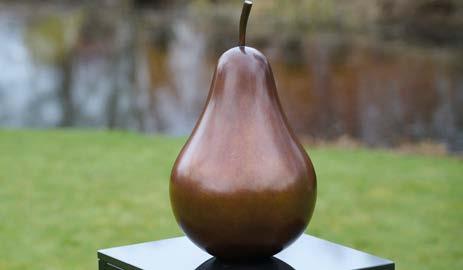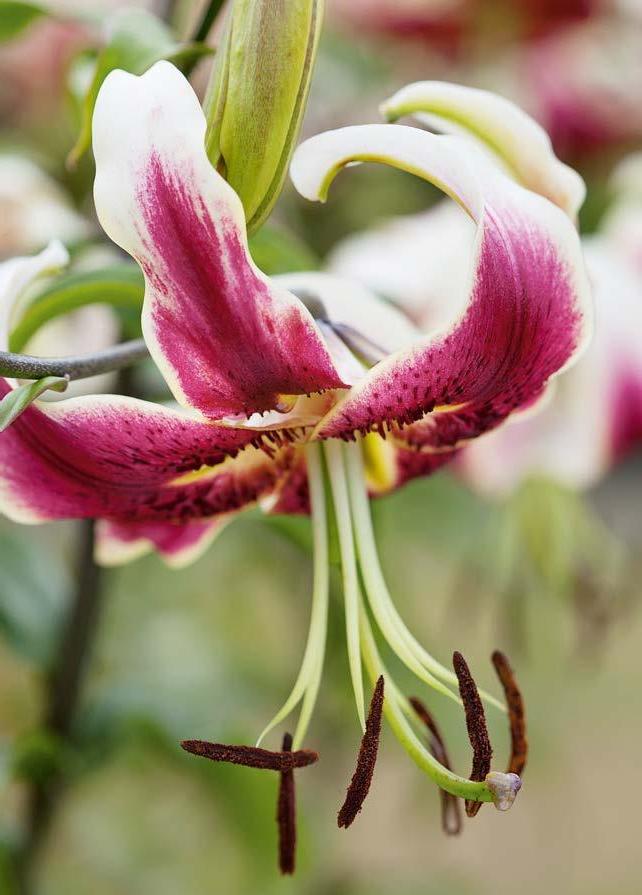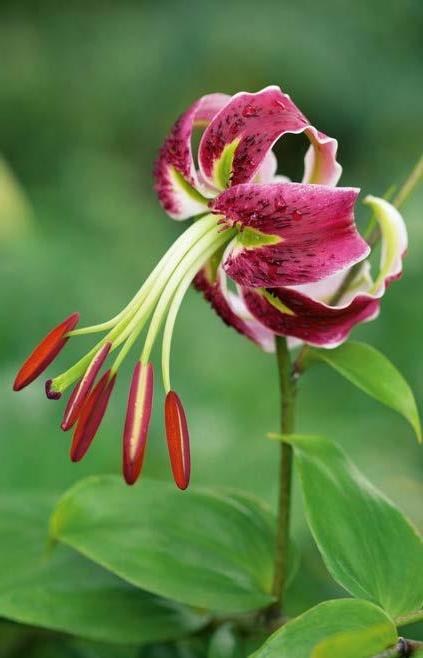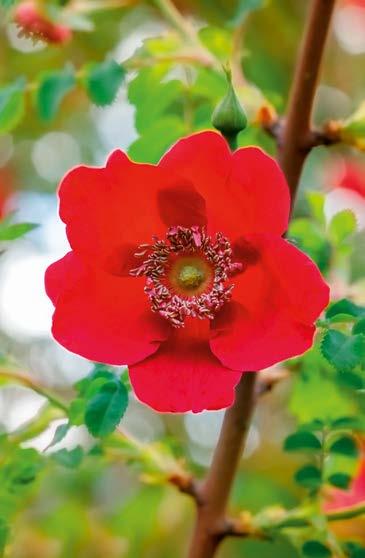
18 minute read
West Sussex Farmhouse Garden
A previously empty expanse of lawn has been transformed with wide beds that link the farmhouse and garden.
Time & PLACE
Garden designer Joe Perkins explains how he set about creating a garden to complement a beautiful medieval and 17th-century West Sussex farmhouse
WORDS JOE PERKINS PHOTOGRAPHS ANNAÏCK GUITTENY

Above Soft shades of purple from Nepeta racemosa ‘Walker’s Low’, Geranium ‘Rozanne’ and silvery Stachys byzantina in new, rectangular borders. A n early-summer paradise of soft but structured planting surrounds this uniquely beautiful farmhouse hidden away in the depths of the Sussex countryside. When I first visited on a cold but sunny early-spring morning, it was immediately apparent that this was a special place. Just the drive in was wonderful – a mile-long cruise through arable farmland, with woods and single stately oaks dotted across the landscape. Approaching the house, the drive became lined with lime trees (Tilia cordata) in a broad sweeping avenue, with low and mid-height grass verges to either side. It was clear that the owners of this 17th-century farmhouse (with medieval origins) were proud of the spectacular setting, and that someone at some point had made a particular e ort to make the approach to the house just as memorable.
I grew up in sleepy countryside just outside Oxford and enjoyed a seemingly nonexistent boundary between our garden and the farmland beyond, so the setting and character of this house brought back happy memories for me. When I was greeted enthusiastically by the owner and her two dogs, it was clear she shared the same passion for a garden that is part of a wider rural landscape.
The beauty of the house, the approach and the landscape were, however, soon overshadowed by the


Top A large pond and a mature weeping willow were already established features in the garden. Above One third of the paving around the pool was lifted and replaced with plants. Left The garden’s designer, Joe Perkins. scene of near-desolation we found ourselves looking at through the all-important kitchen window. She had only recently moved in, and was desperate to get on with ‘dealing’ with the garden, which, she freely admitted, was uninspiring and uninviting; she just didn’t quite know where to start.
As we talked, we studied the view: a huge expanse of lawn, 300m long and as wide as the house, filling the window, with just a few large trees and a native hedge marking the transition back to farmland in the distance. To the west, an enormous leylandii hedge, over 6m tall and almost as wide, blocked a just-asenormous old barn, towering over the lawn and dwarfing anything that dared grow alongside it.


The house is beautiful. Soft red brick, tile-hung gables and roofs covered with mellow clay tiles – a Sussex farmhouse, typical in the best possible way. But the existing garden did very little to embrace the character of the house or its setting and, in fact, was a space in which one felt out of place, even uncomfortable. We agreed as we walked around that there was no sense of place in the garden and standing out in the middle of that expanse of lawn we felt very exposed.
There were some key features – a large pond with quintessential weeping willow, some areas of wildflowers where the lawn drew closer to the boundary hedge, and a walled outdoor swimming pool, although this was an unimaginative space with no planting and a sea of stone paving. These of course had to be integrated into the new design, as did the overpowering hedge – at least for now. There was mention of the huge concrete barn behind it becoming a thing of the past at some point in the future, but this was such an undertaking that the garden would need to be adaptable and incorporate the ‘green giant’ for the time being. There was a fairly free rein on the brief, in respect to layout and design at least, and maintenance – that all-important question to be asked before embarking on any new design – was happily covered by a full-time gardener who had been looking after the property for years and was hugely enthusiastic and inquisitive about the current owners’ new plans. On the other hand, the planting was, to some extent, less free. There were Pinterest boards and colour schemes, David Austin rose catalogues – this was an owner who was good with plants, and knew the essence of what she wanted. There was also a good measure of openness to other ideas and plant suggestions, and it became a very enjoyable collaboration when it came to finalising plant lists, which is really how it should be and the best possible outcome for the long-term development of the garden. There were some red lines: roses had to feature, and yellow was declared out of bounds, although a few varieties of euphorbia were sneaked in on account of their excellent foliage and tough character.
The scheme immediately around the house quickly took shape as a series of rectangular beds enclosing a simple York stone terrace. These beds are lined up with key views both from various windows of the house and with vistas across the width of the house, particularly down to the pond with the willow tree. This structure or layout has the e ect of pausing the transition from the house and terrace to the wider garden, bringing the immediate lawn area down to a smaller scale and
Above Salvia x sylvestris ‘Mainacht’ and Lychnis coronaria ‘Alba’ are repeated across the beds to give them a structured look.





giving both direction and intimacy to the space. The planting here is planned for a predominately late spring and early-summer explosion, with Salvia x sylvestris ‘Mainacht’, Stachys byzantina, Geranium ‘Rozanne’, various bearded iris including ‘Jane Phillips’ and ‘Sable’ and Nepeta racemosa ‘Walker’s Low’. Papaver ‘Patty’s Plum’ helps to bring the colouring across to the pink roses ‘Heritage’ and ‘Queen of Sweden’. There is white, too, with Rosa ‘Winchester Cathedral’ and Delphinium ‘Guardian White’, and the season is extended with lavender and yew topiary cushions nestled in among the perennials. Then there are the bulbs, tulips first, followed by Allium hollandicum ‘Purple Sensation’.
The key to getting the structured look with what is essentially a collection of quite loose and flu y perennials is simplicity and repetition. The borders mirror each other, and although there is variation to add interest, for the most part they tie together visually to create a fairly seamless whole.
As the garden opens out from the house, the planting changes in its season of interest. Two broad sweeping borders map out the fluid curves of the new lawn and are generously planted with grasses (deschampsia species) and late-flowering perennials such as Monarda ‘Croftway Pink’ and Knautia macedonica, with multi-stemmed Amelanchier lamarckii framing the views towards the wildflower meadow and countryside beyond. An oak pergola is positioned to create a superb long vista from the kitchen window, framed with summer-flowering climbing roses and late-flowering clematis varieties. When the hedge is replaced with a smaller boundary of hornbeam, this feature will really come alive. Further out and the grasses give way to shrubs for autumn and winter interest, such as Cornus alba ‘Kesselringii’ and C. ‘Midwinter Fire’, with bigger trees such as cut-leaved alder, Alnus glutinosa ‘Imperialis’, and tulip tree, Liriodendron tulipifera.
The swimming pool garden has been ‘greened up’, losing around 30 per cent of its previously paved surface and benefitting from plantings of olives, lavender and rosemary, as well as the bright Geranium psilostemon and self-clinging Hydrangea petiolaris which will soften the walls given time.
The clients are, it’s safe to say, delighted with the whole scheme. In fact, there has been mild complaint that it is hard to get anything else done due to feeling compelled to sit and admire the views. But that’s a measure of a successful collaboration.
Clockwise from above
Further away from the house, wildflowers forge a tangible link with the countryside beyond; bright pink, black-eyed flowers of Geranium psilostemon; velvety Stachys byzantina; delphiniums in regal purple add height – try ‘Purple Passion’ for a similar e ect.




Incredible Lilium ‘Fusion’, a new hybrid of Lilium pardalinum and L. longiflorum, was one of the best performers in recent lily trials.

Gilding the Lily
If you thought the gorgeous flamboyance of a lily could not be improved on, take a look at some of the best in the RHS’s recent trials, as revealed by trials manager Sabatino Urzo
Despite nearly all of the lilies we grow originating from Asiatic countries or North America, these are plants that seem to be indelibly associated with English gardens. Think of John Singer Sargent’s evocative Carnation, Lily, Lily, Rose, a painting set in a twilit Cotswold garden, glowing Chinese lanterns bobbing between the tall stems of milky white lily flowers, their scent almost discernible from the canvas. Gertrude Jekyll’s 1903 book devoted to the genus, Lilies for English Gardens, cemented their place in the gardening firmament, and their expansion into the thousands of species and cultivars available today only confirms their enduring popularity. But with so many to choose from, how do you find the best for your garden? That’s where the Royal Horticultural Society’s Award of Garden Merit scheme comes in so handy, not just for lilies but for all the plants the Society has trialled over the years. “The plants that undergo AGM trials are assessed by a group of horticultural experts and they have to meet the Award of Garden Merit criteria: excellence for garden use; a good constitution; stability in form and colour; availability for purchase; and reasonable resistance to pests and diseases,” explains Sabatino Urzo, trials manager at RHS Garden Wisley. Not many lilies are holders of the award, and since they were long overdue a trial, Sabatino and his team planted more than 200 separate cultivars and 20 species in Wisley’s trial field in 2018 and began the assessment. But then, a setback: an outbreak of botrytis swept through the lilies during the summer of 2019, the second year of assessment, badly a ecting many of the plants. It’s likely it was made worse by there being so many lilies grown so close together – quite unlike a normal garden situation. “But we like to turn a negative into a positive,” insists Sabatino. “One of the AGM criteria is to spot resistance to pests and disease, and that gave us an opportunity to spot the best of the best, to zoom down to the 30 or so cultivars that didn’t show symptoms of the disease.” Although the results of the trial are yet to be announced, Sabatino is confident that plenty of lilies will win an AGM, and those that do will be the tough customers that sailed through the botrytis attack and still flowered beautifully.
For that’s what most gardeners want in a lily: those beautiful, large, heavily scented megawatt flowers. You need to grow the acid-soil-preferring Oriental lilies to deliver them, advises Sabatino. “They’re renowned for being super fragrant, with a beautiful, large, wide-mouthed flower, generally in pink, white or carmine colours.” For those gardeners who find lily scent overpowering, stick to the Asiatic hybrids, he advises – their fragrance is not nearly as strong. “The Asiatic hybrids are also among the earliest to bloom and the easiest to grow,” he notes,
Above Lilium ‘Pearl White’, an Asiatic hybrid that was one of the trial’s stand-out varieties.



Top left The pendent, raspberry, turk’s caplike flowers of Lilium ‘Scheherazade’. Top right ‘Gold Class’. Above Sugar pink Oriental lily ‘Anastasia’. Left Lilium ‘Mister Cas’, another Oriental type. pointing out that they’ll grow happily in most soils, including alkaline ones. “Asiatics tend to flower between 30 and 45 days after growth begins; Oriental hybrids can take up to three months,” he adds. The bulbs can be planted in spring or autumn. For the RHS trial, Sabatino and his team planted the hybrids in March, but the bulbs of the species went in the autumn before. All the lilies – Asiatic and Oriental – grew in the same soil in Wisley’s trial field. “The Oriental hybrids do perform better in slightly acid soil, the Asiatics perform well in alkaline soil, but we didn’t make any adjustments to our soil’s pH,” he explains. That way, the lilies awarded the AGM should perform well, whatever the soil in our gardens. If you’re worried about your soil pH though, Sabatino suggests you look to another group of lilies that will thrive regardless: martagons. “If you get stuck, they grow in any soil,” he explains. “They’re strong, tough, adaptable, and they’ve got this lovely natural look because they come from mountain woodland environments.”
A lot of Sabatino’s stand-out varieties from the trial were Oriental lilies. One excellent variety that caught his eye was ‘Conca d’Or’. “It’s absolutely gorgeous,” he says. “It’s a lemon-yellow bloom





edged with white and it was one of what I call the ‘super performers’ during the botrytis attack, with healthy leaves and quality flowers.” Pink and white Oriental lily ‘Anastasia’ looks just how lilies ought, sugary confection in a flower, and is another on Sabatino’s super performer list, as is the Trumpet lily ‘Golden Splendor’ – its flowers living up to its name – and Asiatic cultivar ‘Pearl White’, its creamy white blooms featuring a slightly greenish tinge at the centre.
Other Oriental lilies that did well include peachcentred ‘Mister Cas’, dark-speckled ‘Black Beauty’, clotted cream-coloured ‘Felino’, rhubarb-andcustard ‘Flavia’, pendant ‘Gold Class’ and raspberry ‘Scheherazade’. With so much choice it’s just a matter of finding a flower that appeals or fits your colour scheme. “From my point of view, they were all gorgeous,” says Sabatino, of the lilies he rates.
Of the species, L. leichtlinii and L. regale would look superb in any garden scheme. Some lilies with waterlily-like flowers caught the eye of many Wisley visitors while the trial was in bloom – cultivars such as ‘Roselily Sara’. “They’re striking-looking flowers,
Top left ‘Felino’ is an elegant Oriental lily with creamy yellow flowers. Top right The unusual waterlily-shaped bloom of Lilium ‘Roselily Sara’. Above left Vivid orange Lilium tsingtauense. Above right Lilium ‘Golden Splendor’. Right Lilium ‘Flavia’.





Above left Nodding but not bee friendly,” Lilium leichtlinii flowers. admits Sabatino. One Above middle Lilium regale, a classic species. other variety impressed Above right Lilium ‘Black him: ‘Fusion’, a cross Beauty’, named for its between the leopard dark speckled flowers. lily, Lilium pardalinum, and L. longiflorum. “It is absolutely superb, one of the newest in the trial, with large exotic blooms, strong stems and deep red flowers with curved petals,” he enthuses.
One of the trickier aspects of lily growing is integrating them with the rest of the garden – it can be tricky to find the right spot for them in borders. At home, Sabatino says he grows his lilies in containers. Do so and you can put them in pride of place on terraces, to flank doors or mark flights of steps, or move the pots into gaps in borders and see where they look good. “I move my containers into di erent parts of the garden, and bury the pot rather than transplanting to give nice structural impact,” says Sabatino. A large, weighty container is best – at least 35-40cm deep – since lilies can be top-heavy. “To achieve a good aesthetic result, I plant the bulbs very close to each other. This means the pots are dense and full of flowers making a fantastic show.”
Visit rhs.org.uk/plant-trials for more information about AGMs and the lily AGM results later this year.
SUPPLIERS
Breck’s Tel: 1-513-354-1511; brecks.com Brent and Becky’s Tel: 1-877-661-2852; brentandbeckysbulbs.com John Scheepers Tel: 1-860-567-0838; johnscheepers.com
GROWING ADVICE Looking After Lilies
RHS trials manager Sabatino Urzo explains how to get the best out of lily bulbs
Plant lily bulbs in autumn or spring, at a depth three times the height of the bulb itself. Look for healthy bulbs with plump scales and no signs of disease.
Plant them in groups of three for a nice-sized clump. Leave a gap between each bulb that’s about twice the width of the bulb itself – this is particularly important if you plan to leave the bulbs in the ground long term, but less so if they’re going to be lifted at the end of summer.
Lilies like rich, fertile soil, so at planting time, incorporate some slow-release fertiliser to gradually deliver nutrients throughout the growing season. In the run up to and during flowering, give them a weekly or fortnightly dose of a high-potassium fertiliser such as tomato feed mixed into your watering can. It’s also important to keep them watered well during dry weather, while ensuring the bulbs are never waterlogged.
Watch out for lily beetles, making daily inspections and picking the red beetles and their larvae o by hand, squashing them before they can defoliate the plants.
After flowering, cut the stems back by half, so the plants don’t waste their energy turning faded flowers into seedpods. Let the old stems die back and when they have turned completely brown, cut them o about a secateurs’ height above soil level.
Propagate lilies by removing the small bulblets growing close to the main bulb and potting them up separately. Grow them on, feeding and repotting if necessary, and you may start to see flowers appearing after four years.
Single Minded
Blowsy full-petalled roses are beautiful, of course, but single-flowered roses have a charm of their own – and are more attractive to pollinating insects

Rosa spinosissima
Also known as the Dunwich Rose or Scotch rose, this species rose isn’t all that widely grown, but deserves to be much better known. It flowers very early on, from late spring into early summer, when it is smothered in small, creamy-white, scented flowers with a boss of golden anthers in the centre. Its bristly, prickly stems bear small, fern-like leaves and, overall, it reaches about 60cm tall and 90cm across, giving it a lovely mounded shape that’s easy to integrate into mixed borders. You can also grow it as a low hedge, perhaps mixed with other singleflowered roses such as magenta Rosa rugosa or pale pink dog rose, R. canina. The flowers are followed by glossy black hips, which are greatly enjoyed by birds, and the leaves turn shades of amber before falling in autumn.

Rosa moyesii ‘Geranium’
As with Rosa spinosissima, one of the most distinctive characteristics of Rosa moyesii is its feathery fern-like leaves that give the whole shrub an air of light delicacy, despite its size – this is a vigorous rose whose arching branches can reach up to 2.5m in width and height. It dazzles in July and August, producing masses of single, scarlet-red, lightly fragrant flowers, but it’s better known for the hips that follow, which are large, elongated and coral-red in colour. A good-sized plant can absolutely drip with hips in autumn, and the birds will love feasting on them – just remember not to deadhead or prune after flowering if you want the hips to form. If you need to prune, cut back the oldest stems in spring.

Rosa ‘Ringo All-Star’
New to Proven Winners’ 2021 range is this eye-catching rose, ‘Ringo All-Star’, with a fetching flush of crimson at the base of each apricot-pink petal giving the flowers a darker, central ‘eye’. This variety is one of the latest to display this quirky feature in a range of roses that have been bred by Chris Warner. In the UK it won the competitive Rose of the Year award from the British Association of Rose Breeders following a rigorous two-year trial, so you can be confident of excellent garden performance. It needs a sunny spot and good soil to perform at its best and will benefit from a little rose fertiliser applied each spring. Deadheading isn’t necessary, but an annual prune in early spring will help it thrive.
The Anti-Florist
Fiona Pickles of Firenza Flowers eschews the formal and the flamboyant in her floristry, preferring a natural style, home-grown blooms and subtle imperfections that reflect her personal ethos
WORDS CAROLINE BECK PHOTOGRAPHS EVA NEMETH
Fiona Pickles of Firenza Flowers, at home in her garden in the Ryburn Valley, West Yorkshire.









